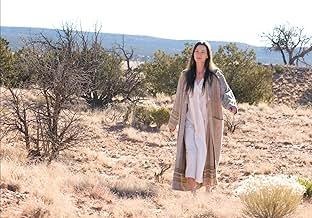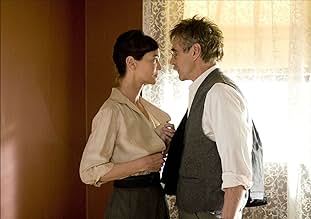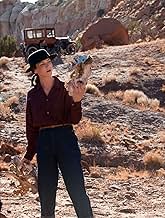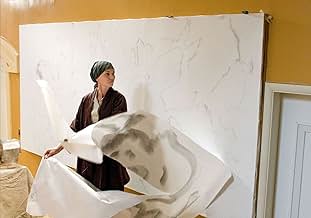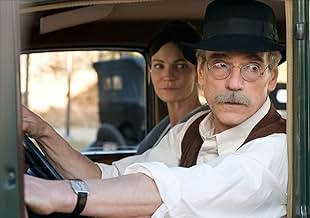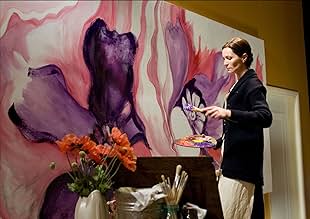अपनी भाषा में प्लॉट जोड़ेंBiopic of American artist Georgia O'Keeffe and her husband, photographer Alfred Stieglitz.Biopic of American artist Georgia O'Keeffe and her husband, photographer Alfred Stieglitz.Biopic of American artist Georgia O'Keeffe and her husband, photographer Alfred Stieglitz.
- 9 प्राइमटाइम एमी के लिए नामांकित
- 1 जीत और कुल 28 नामांकन
फ़ीचर्ड समीक्षाएं
Before seeing this movie, whenever I thought of Georgia O'Keefe I pictured this older woman in a studio in Santa Fe painting flowers and stunning landscapes. This movie finally got to my stereotypical image but it filled in details of O'Keefe's rich, varied, long life along the way.
O'Keefe's work had attracted the attention of famed photographer and art dealer Alfred Stieglitz who exhibited some of her work in New York in 1916. A couple of years later O'Keefe moved to New York and the professional relationship with Stieglitz, who was over twenty years older than her, ultimately turned into a personal one resulting in marriage in 1924.
I always have some reservations about how truthful a biographical picture is, particularly in a case like this where, at the time the screenplay was written, O'Keefe had been dead for over twenty years and most of the people in her life had been dead for upward of fifty years. For example, what are we to take away from the scene about the argument that O'Keefe had with Stieglitz regarding her wanting a child and his blunt refusal? Is that pure speculation? Giving it the benefit of the doubt, I assume the general sweep of her life as presented is accurate, and indeed reading the Wikipedia entry for O'Keefe seems to bear this out. For movies based on a true story I often ask myself why not just read the appropriate Wikipedia entry and skip the movie. But, if properly done, it is easier to get involved in a movie and come away with more lasting impressions. It is often the case that a good movie based on a true story, as this one, will prompt me to do some independent research. There is no lack of O'Keefe biographies, video, and art books out there.
In looking at some of the images of O'Keefe, Stieglitz, and Mabel Dodge, the actors playing those parts (Joan Allen, Jeremy Irons, and Tyne Daly) are well cast as to physical appearance and all do good work.
I wish more of O'Keefe's paintings had been tightly woven into the story.
O'Keefe's work had attracted the attention of famed photographer and art dealer Alfred Stieglitz who exhibited some of her work in New York in 1916. A couple of years later O'Keefe moved to New York and the professional relationship with Stieglitz, who was over twenty years older than her, ultimately turned into a personal one resulting in marriage in 1924.
I always have some reservations about how truthful a biographical picture is, particularly in a case like this where, at the time the screenplay was written, O'Keefe had been dead for over twenty years and most of the people in her life had been dead for upward of fifty years. For example, what are we to take away from the scene about the argument that O'Keefe had with Stieglitz regarding her wanting a child and his blunt refusal? Is that pure speculation? Giving it the benefit of the doubt, I assume the general sweep of her life as presented is accurate, and indeed reading the Wikipedia entry for O'Keefe seems to bear this out. For movies based on a true story I often ask myself why not just read the appropriate Wikipedia entry and skip the movie. But, if properly done, it is easier to get involved in a movie and come away with more lasting impressions. It is often the case that a good movie based on a true story, as this one, will prompt me to do some independent research. There is no lack of O'Keefe biographies, video, and art books out there.
In looking at some of the images of O'Keefe, Stieglitz, and Mabel Dodge, the actors playing those parts (Joan Allen, Jeremy Irons, and Tyne Daly) are well cast as to physical appearance and all do good work.
I wish more of O'Keefe's paintings had been tightly woven into the story.
This was essentially a two-person film. Sure, there were other characters that came in and out: Mabel Dodge Stern (Tyne Daly), Dorothy Norman (Jenny Gabrielle), Tony Lujan (Robert Mirabal), and Selma Steiglitz (Christina Koerber), to name four, but it was the passionate, sometimes stormy relationship between the painter, Georgia O'Keeffe (Joan Allen), and internationally known photographer and gallerist (and philanderer), Alfred Steiglitz (Jeremy Irons), that was displayed here. The New Mexican landscape can also be considered a character, as it enveloped her years after their split.
One of the things that may have helped make this more interesting would be some of the back-story in things that happened. Why didn't Steiglitz want children? There was a good reason. His philandering was also down played. The showing on Lifetime may have served to keep this from being all it could be.
There was some great lines throughout the film. When Stieglitz tells O'Keeffe not to return to her teaching job at West Texas State Normal College, he sniffs: "There's nothing normal in Texas." There are many more great lines, and that makes the film entertaining.
Seeing their relationship develop and falter, and watching how he managed to promote her into one of the greatest American painters was reason enough to tune in. When she overtook him in fame, and we saw Allen's passionate portrayal, it was beautiful.
One of the things that may have helped make this more interesting would be some of the back-story in things that happened. Why didn't Steiglitz want children? There was a good reason. His philandering was also down played. The showing on Lifetime may have served to keep this from being all it could be.
There was some great lines throughout the film. When Stieglitz tells O'Keeffe not to return to her teaching job at West Texas State Normal College, he sniffs: "There's nothing normal in Texas." There are many more great lines, and that makes the film entertaining.
Seeing their relationship develop and falter, and watching how he managed to promote her into one of the greatest American painters was reason enough to tune in. When she overtook him in fame, and we saw Allen's passionate portrayal, it was beautiful.
About a year ago, when the cast was announced for this film, much flurry was made about Henry Simmons playing the role of writer Jean Toomer, the third point in the crucial triangle that really led Georgia O'Keeffe to decide to stay away from Stieglitz.
Imagine the unexpected disappointment when in the broadcast film, Simmons as Toomer was stifled to not a single honest line of dialog! He is reduced to mention in an insane and inaccurate tirade by Stieglitz as "the Black Prince of Harlem" many decades before Malcolm X (to whom the epithet rightly belongs) was born. And these lines sound quite unworthy of a writer the caliber of Cristofer.
Not only was Toomer, a man of mixed race, hardly in Harlem, but he spent most of his life fighting against being classified as a "Negro writer." Then, even more surprisingly, scenes between O'Keeffe and Toomer show up on the Lifetime website and comprise the great majority of what was omitted from the final presentation -- scenes that could shed quite a different light on her choices about remaining in New Mexico.
Obviously, some effort was made to make Joan Allen and Jeremy Irons look like their historical subjects. Simmons does not look like Toomer at all. At least in the old American Playhouse version of the story Vernal Bagneris makes a credible representative.
Moreover, the finished quality of the omitted scenes belies a late cut. It would certainly be interesting to learn something more for the production record, even if not to abate the unanimous canning by the critics. Toomer's disappearing act is one of the major reasons the film failed.
Imagine the unexpected disappointment when in the broadcast film, Simmons as Toomer was stifled to not a single honest line of dialog! He is reduced to mention in an insane and inaccurate tirade by Stieglitz as "the Black Prince of Harlem" many decades before Malcolm X (to whom the epithet rightly belongs) was born. And these lines sound quite unworthy of a writer the caliber of Cristofer.
Not only was Toomer, a man of mixed race, hardly in Harlem, but he spent most of his life fighting against being classified as a "Negro writer." Then, even more surprisingly, scenes between O'Keeffe and Toomer show up on the Lifetime website and comprise the great majority of what was omitted from the final presentation -- scenes that could shed quite a different light on her choices about remaining in New Mexico.
Obviously, some effort was made to make Joan Allen and Jeremy Irons look like their historical subjects. Simmons does not look like Toomer at all. At least in the old American Playhouse version of the story Vernal Bagneris makes a credible representative.
Moreover, the finished quality of the omitted scenes belies a late cut. It would certainly be interesting to learn something more for the production record, even if not to abate the unanimous canning by the critics. Toomer's disappearing act is one of the major reasons the film failed.
I like the basic story; however, I really was disappointed in the director, the DP, and the Gaffer (the person who lights the scenes). The story clearly demonstrated the tumultuous relationship she had with her husband, and control freak, Alfred Steiglitz. That dynamic is very important in explaining who O'Keeffe was. However, I did not like the technical achievements for the NYC shooting (although I hear the whole film was shot in Santa Fe). First of all they used key lights that were too strong and must have had a Kelvin temperature over 7000K--made everybody look (skin tones) extremely cold and blue for all those scenes. This looked weird for something happening in the 1920's-30's. The lighting should have been very warm to match the approximate 2500K light bulbs that existed then. If you want to see a good scene setup, look at Clint Eastwood's "Changeling". Every scene in Changeling was beautiful, and I really felt I was in that time frame. When she went to Taos, NM, the lighting and color pallet looked great. Next I felt that the director tried to accelerate her story, AND I feel the director really messed up after he finally ended the story when she permanently settled in NM and only used "end statements" that stated she's considered 'one of the greatest female painters'. Well YES!!...her greatest work began after the story ended and we see nothing of her fantastic emergence or artistic accomplishments which also included connecting with Ansel Adams(and her former husband was a photographer!!). Her work continued on to 1986 when she finally died, and we see none of this. It was like the point of this film was to only show the tumultuous ordeal with her husband and her eventual breaking away from that poisonous marriage. That was not the title of this film.
I loved this film, mainly because of Joan Allen's brilliance. Jeremy Irons, on the other hand, was overwrought and made the Stieglitz character more of a caricature than the mercurial, talented artist that Stieglitz was in his own right.All of the other characters were incidental, although Ed Begley Jr. acquitted himself admirably.
The New Mexico landscape was wonderful and anything that gave us a glimpse of O'Keefe's talent added to the virtues of the film. Ultimately, though, it was Allen's luminosity that made the film successful; she brought the character alive in a way that no other actress could. She seems to have an uncanny ability, not unlike Meryl Streep, to BECOME any character rather than simply playing a part and following a script. Don't know if she received any awards for the role, but should have.
The New Mexico landscape was wonderful and anything that gave us a glimpse of O'Keefe's talent added to the virtues of the film. Ultimately, though, it was Allen's luminosity that made the film successful; she brought the character alive in a way that no other actress could. She seems to have an uncanny ability, not unlike Meryl Streep, to BECOME any character rather than simply playing a part and following a script. Don't know if she received any awards for the role, but should have.
क्या आपको पता है
- ट्रिवियाOn November 15th, Joan Allen threw a birthday party for Georgia O'Keeffe at her house in Santa Fe for the cast and producers and crew and even had a birthday cake with candles. The next day was the first day of principal photography.
- गूफ़Part of this movie was filmed at Ghost Ranch in New Mexico. When Georgia walks out of the house in the morning she is barefoot. This would never happen in real life due to scorpions, fire ants, Cholla cactus thorns, tumbleweed thorns, and a plant called goat's-head weed. This plant has woody thorns that give the plant its nickname of puncturevine.
- कनेक्शनFeatured in The 62nd Primetime Emmy Awards (2010)
टॉप पसंद
रेटिंग देने के लिए साइन-इन करें और वैयक्तिकृत सुझावों के लिए वॉचलिस्ट करें
विवरण
- चलने की अवधि1 घंटा 29 मिनट
- रंग
- ध्वनि मिश्रण
- पक्ष अनुपात
- 1.78 : 1
इस पेज में योगदान दें
किसी बदलाव का सुझाव दें या अनुपलब्ध कॉन्टेंट जोड़ें


